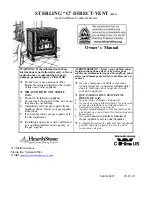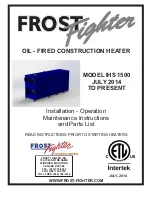
English
•
To supply hot water to upper floors, additional
water pressure (0.44 psi/ft) must be ensured.
The measurement should be calculated by the
distance between the water inlet of the water
heater (ground level) to the hot water faucet
(upper floor level).
•
Well water systems should be set at a range of
50-60 psi.
•
When the water is supplied from a water
supply tank, the height of the tank and the
diameter of the pipes and their relation
to water pressure, should be taken into
consideration. Gravity
water pressure is not
recommended.
NOTICE:
If the water flow resistance of a shower
head is too high, the burner in the water heater
will fail to ignite. Keep the shower head clean from
debris that could cause additional pressure drop.
NOTICE:
If using mixing valves on the outlet,
choose one which prevents cold water pressure
from overcoming hot water line pressure.
IMPORTANT:
Do not apply heat to the HOT or
COLD water connections. Any heat applied to the
water supply fittings will permanently damage the
internal components of the water heater.
Water Supply Connections
Plumbing should be carried out by a qualified
plumber in accordance with local codes.
Use approved plumbing materials and tools only.
To conserve energy and to prevent freezing,
insulate both cold and hot water supply lines.
DO
NOT
cover the drain valves.
To ensure proper operation of the water heater,
the following water pressure guidelines should be
followed:
•
Operation of the water heater requires the
minimum water pressure of 14 psi and a
minimum water flow rate of 0.75 gpm.
•
Additional water pressure is required for long
pipe runs and outlet fitting(s) water pressure
drops.
•
To maintain proper performance, ensure
sufficient water supply pressure. The Required
Water Pressure = Min. Operating Water
Pressure (14 psi) + Pipe Pressure Loss + Faucet
and Shower Pressure Loss + Safety Margin
(more than 5 psi).
Mounting the 20H Outdoor Tankless Water
Heater
Make sure the location of the water heater allows for easy access and operation. The water
heater should be located in an area where leakage of the tank or connections will not result
in damage to the area adjacent to the water heater or to lower floors of the structure. When
such locations cannot be avoided, it is recommended that a suitable drain pan, adequately
drained, be installed under the appliance. The pan must not restrict combustion air flow.
In case of dry wall or concrete wall use dry wall anchors or lag bolts.
The water heater requires 120VAC/ 60Hz. Have a receptacle with ground terminal near the
water heater. The length of the power supply cord is 5 feet.
Drill the holes as per the sizes in the figure to the left, put 2 expansion screws into the top
holes, and 2 rubber screws into the bottom holes.
Hang up the water heater unit, tighten the expansion screws, and put 2 wood thread screws
into the bottom holes.
When being installed directly on carpeting, the water heater shall be installed on a metal or
wood panel extending beyond the full width and depth of the water heater by at least 3 in
(76.2 mm) in any direction or, if the water heater is installed in an alcove or closet, the entire
floor shall be covered by the panel. The panel must be strong enough to carry the weight of
the heater when full of water.
CAUTION: Reinforcement of the wall is required in case the wall is not strong enough to hold the water heater.
CAUTION: This water heater must only be used with the following water supply system conditions:
• With clean, potable water free of corrosive chemicals, sand, dirt, or other contaminates.
• With inlet water temperatures above 32°F, but not exceeding 120°F.
• Free of lime and scale deposits.
• DO NOT reverse the hot and cold water connections. The water heater will not operate.
20H Installation
















































